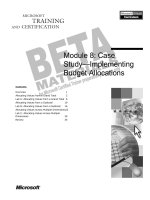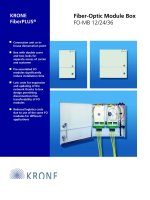Tài liệu Properly Training Next-Generation Technicians on Next-Generation Products pptx
Bạn đang xem bản rút gọn của tài liệu. Xem và tải ngay bản đầy đủ của tài liệu tại đây (214.18 KB, 4 trang )
WHITE PAPER
Properly Training
Next-Generation Technicians
on Next-Generation Products
Properly Training FTTx Technicians on
Next-Generation Products
With all the issues and considerations associated with pushing optical fiber
and equipment closer to the end user, it’s imperative that carriers don’t neglect
their most important resource – the network technician. Although some
responsibilities may differ with each section of the fiber-to-the-premise (FTTP)
architecture, there are also some basic procedures that apply from end to end.
It’s also important to realize that many technicians have honed their skills amid
different types of telecom architectures, such as copper or hybrid fiber-coax
(HFC). These technicians have already developed many techniques that are
different than in the optical environment where proper cleaning and handling
are critical to the operation of the system.
Even new technicians should be reminded that many seemingly tedious
and repetitive procedures could impact overall network operations if not
performed regularly and correctly. This paper will address a few key issues
related to ensuring your technicians understand the “how” and “why” for
practicing good techniques and procedures necessary for working in the optical
environment of FTTP.
New process and procedures
Many technicians have been around the telecommunication industry for
years, acquiring lots of experience that makes them valuable assets to the
organization. However, some of these same technicians have no experience
with optical fiber. A willingness to add the unique characteristics of working
with fiber to their knowledge arsenal is necessary, if not critical. For instance,
some techniques that worked well in a copper environment may not
necessarily apply to fiber architectures.
We’ll look at the central office (CO) of the FTTP first – specifically, the point
at which it interfaces with the optical line terminal (OLT). As with much of
the FTTP architecture, a key issue in the CO is the cleanliness of connectors. It
cannot be overemphasized that any time two connectors are mated, each must
be properly cleaned. Any failure to clean any connector invites contamination
that can affect performance.
Page 3
In addition to good cleaning practices, the proper
routing and management of patch cords within the CO
is also necessary. The fiber distribution frame located in
the CO can have as many as 1728 fiber terminations.
A fiber distribution frame that enables quick and
efficient turn up, testing, and reconfiguration of the
network begins with technicians applying sound cable
management practices.
Technicians require thorough training on four key aspects
of cable management: bend radius protection, proper
connector handling, cable routing paths, and physical
protection. Teaching technicians to ensure all fiber bends
are protected by using the fiber frame management
properly, will ensure long-term optical performance and
the ability to support future high-speed services.
Physical connector handling inside the fiber distribution
frames, such as when removing, cleaning, or replacing a
connector, can be difficult in a high-density fiber frame.
With limited access, even experienced technicians may
be tempted to overlook proper cleaning or handling in
the interest of time. For that reason, some frames are
designed to allow tool-less access to both front and
rear connectors without disturbing adjacent fibers or
connectors, enabling easier access and a higher likelihood
that technicians will adhere to proper handling and
cleaning practices.
Technicians should also ensure proper routing paths are
followed within the fiber distribution frame system. The
quality of the cable routing paths within the system can
be the difference between congested chaos and neatly-
routed, easily-accessed patch cords. It’s often said that
the best teacher in fiber routing techniques is the first
technician to route it properly. Conversely, the worst
teacher is the first to use improper techniques since
subsequent technicians are likely to follow his lead.
Technicians must also be aware of physical safety issues
resulting from high-power lasers used in the network.
Connectors should never point directly at technicians.
Since lasers are infra-red, it’s important to take
precautions when exposure is possible. Designs that have
connector ports pointing side-to-side rather than straight
out of the panel, or that utilize some sort of shutter
system, can increase eye protection for technicians,
regardless of their level of training or awareness.
Technicians in the fi eld
Technicians with responsibilities for the outside plant
portions of the network are required to abide by similar
practices, standards, and procedures carried over from
the CO. Since fiber distribution hubs (FDHs) are designed
with components similar to the CO equipment fiber
frames, the same cleaning and fiber management
practices should be employed. As previously stated, since
many technicians have only worked in the OSP and never
in the CO, many common CO practices are new to them,
particularly in transitioning from copper to fiber.
Most carriers today are migrating to a connectorized
FDH as opposed to straight spliced cabinets. Better loss
characteristics achieved by new connector and splitter
products have helped achieve acceptable loss budgets
while adding the flexibility advantages allowed through
a connectorized architecture. In terms of technician skill
sets, connectorized inputs are much more cost effective
since splice technicians are not required and connections
can be made without the need for a splicer.
Additionally, easier test access is enabled at the FDH.
For example, a technician can simply unplug the
connector at the test point, connect the test equipment,
conduct the appropriate test procedure, and then
replug the connector back into the original port
when finished. Again, it’s worth reemphasizing that
cleanliness of the connectors remains paramount. ADC
always recommends cleaning both connectors on the
distribution interface – on the distribution panel and at
the splitter output.
Also, proper patch cord routing from the splitter parking
lot to the distribution port is important to avoid bend
radius loss issues. Although fiber patch cord routing is
critical and instructions are clear and concise on ADC
products, it’s still not uncommon to see cabinets in the
field that have been improperly managed.
Figures 1 and 2 show the difference between poor
fiber routing and proper fiber routing. It’s easy to see
which cabinet will enable future technicians to locate
and manipulate specific fibers when turning up service
or reconfiguring the cabinet. Again, whether it’s a case
of untrained technicians or simple carelessness, once
the first technician gets sloppy and ignores proper
procedures, chances are good the next technician will
follow that lead.
Properly Training Next-Generation Technicians on Next-Generation Products
Figure 1.
Poor Fiber Routing
Figure 2.
Correct Fiber Routing
Close up shows
fi bers improperly
crossing over
one another
causing a
tangled mess.
Close up of
same area
shows fi bers
routed correctly.
WHITE PAPER
Even though the first technician in the cabinet may not see proper fiber routing as an important issue since
there are only a few customers served by the cabinet, as more customers are added, the proper routing
technique takes on greater importance. In fact, training technicians to adhere to proper routing procedures
early will make new connections much easier and mitigate the potential for future network problems.
Test equipment familiarity
Finally, technicians require proper training on test equipment. For example, although most technicians
receive training on the optical time domain reflectometer (OTDR) and know how to use the machine,
they may not be sufficiently educated on evaluating exactly what they are looking at when viewing the
trace. There is often a fine line between connecting or operating the equipment and evaluating the data.
For instance, a technician may test from Point A to Point B across half a mile of cable with several
splices and connection ports. A normal loss from a particular connection point may lead a less-trained
technician to the conclusion that a problem exists at that point in the network. A better trained
technician would know exactly where the connection point should be located and realize a certain
amount of loss is expected – saving time and effort by preventing an unwarranted truck roll.
Experienced technicians will also make comparisons to the initial testing traces that were documented
during the first tests on a particular link. The original test data is typically saved in a data base to enable
such comparisons when loss is detected. To the trained technician, these initial test traces are a valuable
reference tool for future troubleshooting and maintenance decisions.
Carriers must make it standard procedure to correctly train all their technicians, from the CO to the OSP,
in proper craft practices. If every technician employs the same proper technique in connector cleanliness,
test procedures, fiber routing/management, record keeping, and overall fiber handling, operational costs
can be drastically reduced over the life of the network.
Web Site: www.adc.com
From North America, Call Toll Free: 1-800-366-3891 • Outside of North America: +1-952-938-8080
Fax: +1-952-917-3237 • For a listing of ADC’s global sales office locations, please refer to our Web site.
ADC Telecommunications, Inc., P.O. Box 1101, Minneapolis, Minnesota USA 55440-1101
Specifications published here are current as of the date of publication of this document. Because we are continuously
improving our products, ADC reserves the right to change specifications without prior notice. At any time, you may
verify product specifications by contacting our headquarters office in Minneapolis. ADC Telecommunications, Inc.
views its patent portfolio as an important corporate asset and vigorously enforces its patents. Products or features
contained herein may be covered by one or more U.S. or foreign patents. An Equal Opportunity Employer
103329AE 9/06 Revison © 2006 ADC Telecommunications, Inc. All Rights Reserved
Poor Cable Routing
Correct Cable Routing
Close up shows
fi bers improperly
crossing over
one another
causing a
tangled mess.
Close up of same
area shows fi bers
routed correctly.









